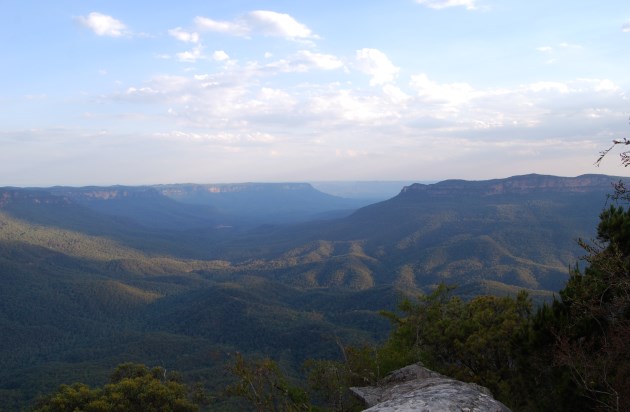Australia Tourist Guide -> New South Wales Tourist Guide -> Outer NSW Regions -> Blue Mountains NSW -> Valleys of the Blue Mountains

Photo: Blue Mountains Valley with its Bluish Tinge.
Blue Mountains NSW
About the Blue Mountains
- Ancient Landscapes of Australia
- Blue Mountains Homes
- Summer in the Mountains
- Animals and Birdlife
- Blue Mountains Places to Eat
Places of Interest
- World Heritage Blue Mountains
- Three Sisters
- Hartley Village
- Jenolan Caves
- Valleys of the Blue Mountains
- Mountain Peaks
- Warragamba Dam
Towns and Villages
Surrounds
Maps
Australia Tourist Guide -> New South Wales Tourist Guide -> Outer NSW Regions -> Blue Mountains NSW -> Valleys of the Blue Mountains
Mobile Version: Mobile


Valleys of the Blue Mountains
These valleys are below the ridges of the Blue Mountains to the west. You can get fantastic views of these places from Blackheath, Katoomba and Mt. Victoria, the highest point along the Great Western Highway:
Map
Megalong Valley
With views of the steep ridges that mark the valley and vast forests of eucalypt, the valley has plenty of bush experiences on offer. Although most of Megalong Valley is occupied for farming, it can best be explored on horseback. There are numerous riding trails throughout much of it. Camping is available at Old Ford Reserve.
Six Foot Track
Another remarkable way to explore this valley is to take the The Six Foot Track, a 3 day, 44 kilometre walk track. It winds it way down and along the upper valley, the Cox’s River and eventually to the:
Jenolan Caves
Only re-opened recently, it was originally created to try and attract more visitors to Katoomba in the 1840s and to give easier access to places in the valley below. The trail begins at the Explorers Tree in the town.
When the railway that crosses the Blue Mountains was completed, it became easier to take the train to Hay or to :
Lithgow
Jamison Valley
Dividing Megalong and the Jamison Valley is the Narrow Neck Plateau, a long narrow ridge that can be seen from various lookouts at Leura and at Katoomba. There are bike tours available with amazing views along the way.
Jamison Valley also offers numerous walking tracks of varying length and difficulty, there are also places to camp. At Katoomba there are scenic rides that allow you to take in expansive views. You can also ride their Scenic Cableway, which is a short but steep rail ride into the valley below.
The Coxs River created this valley over millions of years. There are a number of waterfalls that you can visit, including Wentworth Falls, the Gordon Falls, the Leura Falls and the Katoomba Falls.
Lithgow Valley
Lithgow Valley has national parks and historical places to visit:
Lithgow Surrounds
Grose Valley
Fed by the Grose River, this valley has developed gorges and canyons, with some of the steepest cliffs of the Blue Mountains. The river eventually ends up in the Hawkesbury Nepean.
Important as a conservation area, you can explore the valley along a number of walking tracks. Grose Valley can be viewed from Pulpit Rock and and Govetts Leap, both at:
Blackheath
Other Valleys
Other places to visit in this part of the Blue Mountains include Kedumba Valley and Cedar Valley.
More Australia Places of Interest - See:
Search the Australia Tourist Guide